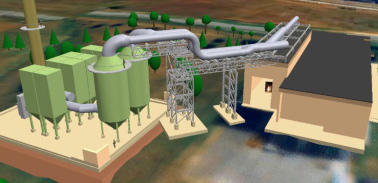Summary
The capabilities of the NIST National Fire Research Laboratory (NFRL) will be extended to provide a test bed for performance evaluation of instruments and test methods used for the monitoring of greenhouse gas emissions from point sources at close to industrial scale. In addition, atmospheric dispersion models will be assessed and developed to design optimal placement of sensor systems and to provide realistic and substantial uncertainty estimates of greenhouse gas emissions from area sources based on sensor field measurements.
Description

Objective - Create a well-characterized highly accurate reference measurement system at near industrial scale to demonstrate a framework for conducting low-uncertainty measurements of carbon dioxide emissions, and to improve and evaluate atmospheric dispersion models for reducing model uncertainties in greenhouse gas source prediction.
What is the new technical idea?
The new technical idea is to use measurement science and state-of-the-art CFD modeling to characterize greenhouse gas (GHG) emissions and transport in order to create sound scientific data that can be used to better understand the performance of green buildings and communities. Two project tasks are emphasized:
The first task is to use the National Fire Research Laboratory’s (NFRL) exhaust duct and stack as a surrogate for a close to full scale industrial facility or small power plant (10 MW). Well-characterized measurements of CO2 emission rates from the NFRL will allow it to serve as a test bed for point source measurements. Reduced uncertainties will be achieved by employing a well-controlled and well-characterized combustion source of CO2 and through systematically improving the accuracy of the component measurements. The facility will be used as a CO2 emissions test bed to evaluate current stack-mounted test methods and continuous emission monitoring systems (CEMS) as well as new technologies for open-path remote sensing and stack-mounted measurement systems.
For the second task, we propose to reduce the uncertainty associated with predicting emissions from area source inventories of greenhouse gases. Industry currently estimates greenhouse gas emissions based on the raw materials that go into factories or power plants (a so called “bottom-up” calculation). Countries tabulate these estimates to report nationwide figures of greenhouse gas inventories. These emission inventories are used in models to estimate the atmospheric chemical composition. However, there are large uncertainties in bottom-up estimates. Atmospheric measurements suggest that GHG emissions can be double of those based on bottom-up calculations (i) (ii) . The new technical idea is to use atmospheric concentration measurements and inversion methods as part of a top-down calculation to evaluate and improve existing emission inventories. Development and validation of the inversion models will provide an estimate of model uncertainty and will form the scientific basis for verification and monitoring of greenhouse gas emissions. Strong collaboration with academia, industry, and national research laboratories as well as the availability of validated software tools and computer resources will ensure that results are achieved in a timely fashion.
What is the research plan?
The research plan consists of two major components, a) reduction of the measurement uncertainty for point source emissions, and b) reduction of the uncertainty associated with the use of atmospheric dispersion models for use in inversion modeling.
We will extend the capabilities of the NFRL to provide an emissions test bed, at near industrial-scale, for the performance evaluation of instruments of the type generally used for CEMS and relative accuracy testing audits (RATA). The NFRL will become a model facility for conducting low uncertainty measurements of CO2 emissions. Measurement improvements include better calibration gas standards, measurements of unburned hydrocarbons for evaluating combustion efficiency, independent flow measurements for cross validation, optimization of probe locations using detailed mapping experiments, and more accurate calibrations for flow and gas measurement probes and transducers. The research results from the NFRL will be used to generate best practice guidelines for reducing the uncertainty of emissions measurements, and assist in the development and improvement of documentary standards for the industry. Ultimately, these new measurements and standards capabilities will lead to improvements in determination of greenhouse gas emission inventories. (iii)
We propose to develop a test bed in Washington DC / Baltimore to demonstrate the application of top-down inversion methodologies for estimating greenhouse gas emissions from urban domains. A network design analysis will be performed to choose surface stations for greenhouse gas measurements as well as to collect meteorological data. Spectrometer data from instruments mounted on a tower / aircraft as well as from low-cost sensors will be collected. The focus of the modeling work will be on predicting CO2 and CH4 emissions from area source inventories by using atmospheric mixing ratio observations and wind field estimates in an inversion framework. Inversion models will be coupled with computational fluid dynamics (CFD) software tools such as NIST Fire Dynamics Simulator (FDS) and Weather Research and Forecasting (WRF) for estimating uncertainty and sensitivity to model parameters. Since the model domain includes a large city, much of the flow is over an urban topography. Using WRF and FDS, NIST will investigate the effects of the urban canopy at horizontal resolutions of 10 m to 20 m and test the efficacy of the method through comparison of model results with well-known field experiments. These methods will have the capability to account for complex urban topography, but are also expected to be computationally intensive. Simulations will be performed to evaluate the optimal location of sensors in an effort to maximize the emission signatures. These simulations will guide the strategic deployment of measurement locations in Washington DC / Baltimore, and provide accurate estimates of greenhouse gas emissions.
Major Accomplishments
Outcomes:
- Developed software tools and demonstrated the measurement capability to accurately locate greenhouse gas sources and measure their flux to the atmosphere at urban and regional locales.
- Developed the capability to compare independent measurements of exhaust duct volume flow rate in the National Fire Research Laboratory

